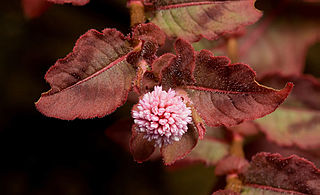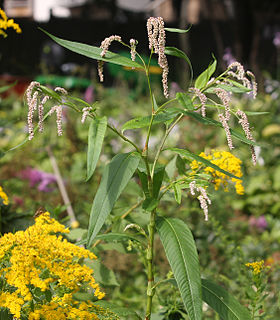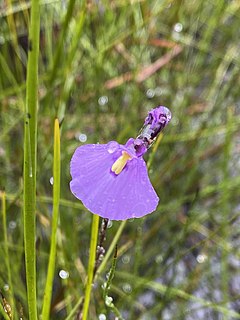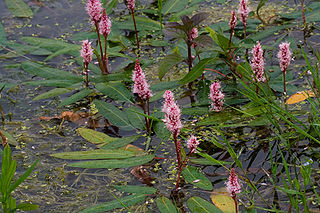
Persicaria is a genus of herbaceous flowering plants in the knotweed family, Polygonaceae. Plants of the genus are known commonly as knotweeds or smartweeds. It has a cosmopolitan distribution, with species occurring nearly worldwide. The genus was segregated from Polygonum.

Polygonum is a genus of about 130 species of flowering plant in the buckwheat and knotweed family Polygonaceae. Common names include knotweed and knotgrass. In the Middle English glossary of herbs Alphita, it was known as ars-smerte. There have been various opinions about how broadly the genus should be defined. For example, buckwheat has sometimes been included in the genus as Polygonum fagopyrum. Former genera such as Polygonella have been subsumed into Polygonum; other genera have been split off.

Persicaria maculosa is an annual plant in the buckwheat family, Polygonaceae. Common names include lady's thumb, spotted lady's thumb, Jesusplant, and redshank. It is widespread across Eurasia from Iceland south to Portugal and east to Japan. It is also present as an introduced and invasive species in North America, where it was first noted in the Great Lakes region in 1843 and has now spread through most of the continent.

Persicaria lapathifolia, known as pale persicaria, is a plant of the family Polygonaceae. It is closely related to Persicaria maculosa and as such is considered a weed in Britain and Europe. Other common names for the plant include pale smartweed, curlytop knotweed, and willow weed. It is a species complex made up of a great many varying forms, sometimes considered varieties. The environment also has a strong influence on the morphology of an individual plant.

The Japanese rhinoceros beetle, Japanese horned beetle, or kabutomushi (カブトムシ), Allomyrina dichotoma, is a species of rhinoceros beetle.

Utricularia dichotoma, commonly known as fairy aprons, is a variable, perennial species of terrestrial bladderwort. It is a widespread species with mauve or purple fan-shaped flowers on a slender stalk and usually grows in wet locations.

Hyphaene dichotoma is a species of palm tree in the family Arecaceae. It is found in India and Sri Lanka. It is threatened by habitat loss.
Dactyladenia dichotoma is a species of plant in the family Chrysobalanaceae. It is endemic to Nigeria. It is threatened by habitat loss.

Persicaria capitata, the pink-headed persicaria, pinkhead smartweed, pink knotweed, Japanese knotweed, or pink bubble persicaria, is an Asian species of plants in the genus Persicaria within the buckwheat family. It is native to Asia and grown as an ornamental in other countries. It has become naturalized in Australia, South Africa and a few scattered locations in the United States.
Persicaria cespitosa, known as tufted knotweed, is a summer annual weedy plant of the family Polygonaceae, native to eastern Asia, from China to Japan and Southeast Asia, and introduced into North America. The plant grows to 3.5 feet (105 cm) in height with elliptic to lanceolate leaves, usually 20–75 mm long. It has small pink or red flowers arranged in tight terminal spikes.

Persicaria chinensis, commonly known as creeping smartweed or Chinese knotweed, is a plant species from the family Polygonaceae. It is widespread across China, Japan, the Indian Subcontinent, Indonesia, Malaysia, and Vietnam. It is a common plant in Malaysia and Vietnam, where it is used in herbal remedies, such as for the treatment of dysentery, enteritis, and sore throat. It is a weed in some coastal areas of New South Wales and Queensland in Australia.

Cordia dichotoma is a species of flowering tree in the borage family, Boraginaceae, that is native to the Indomalayan realm, northern Australia, and western Melanesia.

Persicaria amphibia is a species of flowering plant in the knotweed family known by several common names, including longroot smartweed, water knotweed, water smartweed, and amphibious bistort. It is native to much of North America, Asia, Europe, and parts of Africa, and it grows elsewhere as an introduced species and sometimes a noxious weed.

Persicaria hydropiperoides is a New World species of flowering plant in the buckwheat family known by the common names swamp smartweed and false waterpepper. It is widespread across much of North America and South America. It grows in moist and wet habitats, and is sometimes semi-aquatic.

Persicaria decipiens, commonly known as slender knotweed, is a species of flowering plant native to Australia and Asia.

Persicaria attenuata is a species of flowering plant native to Australia and Asia. It typically grows in wet land or streams.
Persicaria elatior, commonly known as tall knotweed, is a species of flowering plant native to eastern Australia. It was one of eleven species selected for the Save a Species Walk campaign in April 2016; scientists walked 300 km to raise money for collection of seeds to be prepared and stored at the Australian PlantBank at the Australian Botanic Garden, Mount Annan.

The Flora of Nepal is one of the richest in the world due to the diverse climate, topology and geography of the country. Research undertaken in the late 1970s and early 1980s documented 5067 species of which 5041 were angiosperms and the remaining 26 species were gymnosperms. The Terai area has hardwood, bamboo, palm, and sal trees. Notable plants include the garden angelica, Luculia gratissima, Meconopsis villosa, and Persicaria affinis. However, according to ICOMOS checklist, in the protected sites, there are 2,532 species of vascular plants under 1,034 genera and 199 families. The variation in figures is attributed to inadequate floral coverage filed studies.

Persicaria nepalensis is a species of flowering plant in the family Polygonaceae, native to eastern Africa, including Madagascar, and parts of Asia. It has been introduced elsewhere: parts of Europe, North America and northern South America. The species was first described as Polygonum nepalense by Carl Meissner in 1826, and transferred to Persicaria by Hugo Gross in 1913.

Persicaria orientalis is a species of flowering plant in the family Polygonaceae, known as kiss-me-over-the-garden-gate and princess-feather. It was first described, as Polygonum orientale, by Carl Linnaeus in 1753. It was transferred to the genus Persicaria by Édouard Spach in 1841. Its native distribution is unclear. As of May 2019, Plants of the World Online lists only Uzbekistan, whereas other sources give a much wider distribution in temperate and tropical Asia and Australia. It is widely cultivated and naturalized.
















